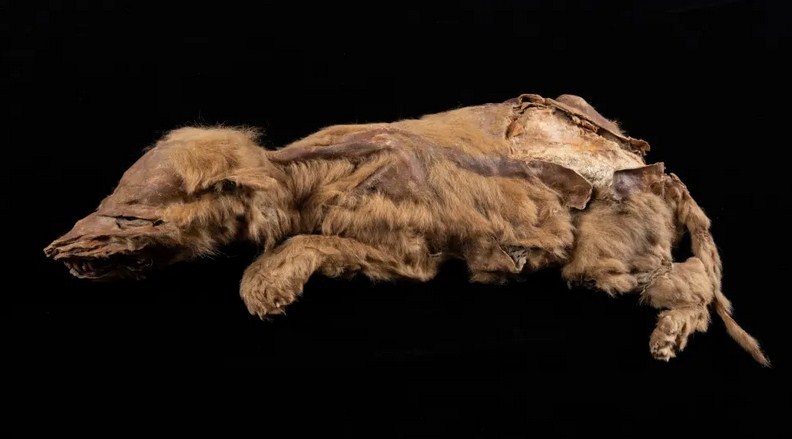A pup wolf that lived 57,000 years ago, with a well-preserved body occasioned by the permafrost which kept her body free from the natural decaying process, is the subject of a new study recently published in Current Biology.
The pup wolf was discovered by Neil Loveless, a gold miner in Yukon’s Territory of Canada in 2016. He was blasting through a wall of permafrost using a water cannon to get through whatever laid inside when he made the accidental discovery – the mummy of a complete wolf, Gizmodo reports.
When paleontologists examined the treasure, they found out that the wolf, which was female, probably lived for only about six or seven weeks before it died due to the collapse of her abode. It was the perfect preservation of her body by the permafrost that made knowledge of her existence tens of thousands of years ago possible.
It is also the oldest wolf mummy discovered. It existed in times when the whole of northwestern Canada was home to American mastodons. The wolf now bears the name Zhur, which means “Wolf” in the local language of the Tr’odëk Hwëch’in people.
A lot of findings concerning rare mammals that lived through the Pleistocene epoch have been made from the Siberian tundra. This period, otherwise known as the Ice Age lasted about 2.6 to 11,700 years ago. However, no such wolf that comes in its complete form has ever been found.
Julie Meachen, a paleontologist from the Des Moines University, and a lead author of the study said such finds as Zhur are common in Siberia due to the large concentration of permafrost. However, the same cannot be said of places like Yukon, Alaska, and other areas in North America.
The fossil of Zhur retains many complete parts of her body even after thousands of years – from her fur to coat, to her tongue. Ross Barnett of the University of Copenhagen, who was not a part of the study, described the preservation of Zhur as amazing.
According to Meachen, Zhur has helped scientists discover a lot. Analysis of her body revealed at what age she died, said to be around six to seven weeks, and even the food she ate prior to her death, the National Geographic writes.
The study was also able to reveal what it was like during the period Zhur lived on earth. Zhur is said to have lived during an interglacial, when the Arctic glaciers temporarily moved away, allowing the woodlands to take over. During this time, animals like the mastodons, camels, giant beavers, and gray wolves roamed the earth.
They may be found in their numbers in North America today, however, gray wolves originated from Eurasia more than 500,000 years ago. Not much is known of the time when Zhur existed but many of the wolf species that lived during that period no longer exist.
The study revealed that Zhur had been weaned, and was expected to begin eating solid food when she passed on. Her teeth suggested that her diet came from streams and rivers. The collapse of her den shortened her life. The quick burial on permafrost did the job of preservation.
Experts said further study of Zhur’s DNA would provide scientists with more revelation into how her kind fared during the Pleistocene period. It would also show how other varied animal populations progressed giving scientists a peep into the Ice Age.
Source: gizmodo.com








